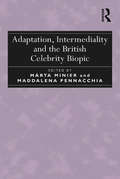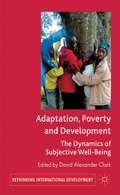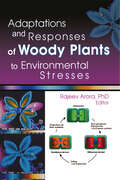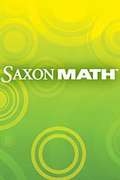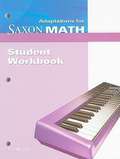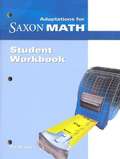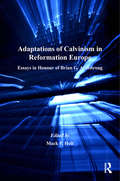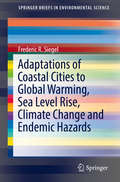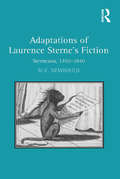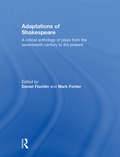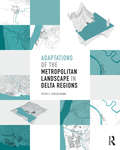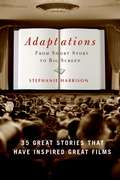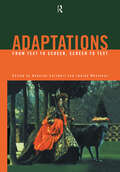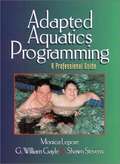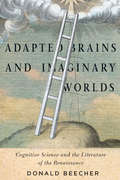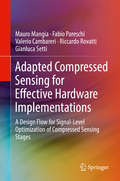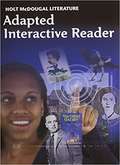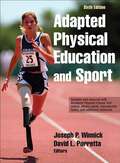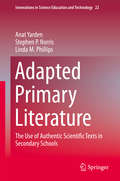- Table View
- List View
Adaptation, Intermediality and the British Celebrity Biopic
by Márta Minier Maddalena PennacchiaBeginning with the premise that the biopic is a form of adaptation and an example of intermediality, this collection examines the multiplicity of 'source texts' and the convergence of different media in this genre, alongside the concurrent issues of fidelity and authenticity that accompany this form. The contributors focus on big and small screen biopics of British celebrities from the late twentieth and twenty-first centuries, attending to their myth-making and myth-breaking potential. Related topics are the contemporary British biopic's participation in the production and consumption of celebrated lives, and the biopic's generic fluidity and hybridity as evidenced in its relationship to such forms as the bio-docudrama. Offering case studies of film biographies of literary and cultural icons, including Elizabeth I, Elizabeth II, Diana Princess of Wales, John Lennon, Shakespeare, Jane Austen, Beau Brummel, Carrington and Beatrix Potter, the essays address how British identity and heritage are interrogated in the (re)telling and showing of these lives, and how the reimagining of famous lives for the screen is influenced by recent processes of manufacturing celebrity.
Adaptation, Poverty and Development
by David Alexander ClarkIn contrast to previous attempts to examine adaptation to climate change in developing countries, the authors focus on how individuals and broader social groups adjust their aspirations, mental states, social values and behaviour as well as practices in response to changes in their personal and social circumstances. Employing a unique blend of cross-disciplinary work from economics, psychology, sociology and philosophy, this innovative book draws on quantitative and qualitative techniques. The three sections deal with conceptual issues, empirical studies and specific topics (gender, disability, migration) relating to adaptation in developing countries. It includes detailed case studies of adaptation in China, Ethiopia, India and South Africa and underlines the case for listening to the poor by suggesting that people who become worse off are less likely to lower their aspirations or restrict their values than is commonly thought by some philosophers and social scientists. "
Adaptation, Specialization, and the Theory of the Firm
by Birger WernerfeltThis invaluable book provides the foundations for a new theory of the firm, drawing on Birger Wernerfelt's landmark work on economic theory and the resource-based view of the firm. It addresses a vigorous and long-standing academic debate over what exactly a 'firm' is, both in the field of management and economics. Wernerfelt revisits his classic articles, including an extensively revised 'A Resource-Based View of the Firm' (1984), which have been updated and synthesized to provide precise and accessible concepts and predictions. By offering future directions for research and practice, this book will be of interest to students and scholars of management and economics alike.
Adaptation: Strategies for Global Value Creation
by Pankaj GhemawatThis chapter focuses on adaptation strategies for adding value in the face of large cross-border differences, exploring in detail the strategies of the world's ten largest competitors in the major home appliance industry. This chapter was originally published as chapter 4 of "Redefining Global Strategy: Crossing Borders in a World Where Differences Still Matter."
Adaptation: Studying Film and Literature
by Peter Hawkes John M. DesmondThis concise and readable new text for courses in Film Adaptation or Film and Literature introduces students to the art of adapting works of literature for film. Adaptation describes the interwoven histories of literature and film, presents key analytical approaches to adaptation, and provides an in-depth overview of adaptations of novels, short stories, plays, nonfiction, and animation. The book concludes with an analysis of why adaptations sometimes fail.
Adaptations and Responses of Woody Plants to Environmental Stresses
by Rajeev AroraDiscover what improves stress resistance to cold in woody plants used in horticulture! Adaptations and Responses of Woody Plants to Environmental Stresses covers the latest and most significant advances in woody plant stress research. Few books focus on the low-temperature stress biology of woody plants that are of horticultural importance
Adaptations for Saxon Math Student Reference Guide Intermediate 3-5
by Pat WrigleyNIMAC-sourced textbook
Adaptations of Calvinism in Reformation Europe: Essays in Honour of Brian G. Armstrong (St Andrews Studies in Reformation History)
by Mack P. HoltTraditional historiography has always viewed Calvin's Geneva as the benchmark against which all other Reformed communities must inevitably be measured, judging those communities who did not follow Geneva's institutional and doctrinal example as somehow inferior and incomplete versions of the original. Adaptations of Calvinism in Reformation Europe builds upon recent scholarship that challenges this concept of the 'fragmentation' of Calvinism, and instead offers a more positive view of Reformed communities beyond Geneva. The essays in this volume highlight the different paths that Calvinism followed as it took root in Western Europe and which allowed it to develop within fifty years into the dominant Protestant confession. Each chapter reinforces the notion that whilst many reformers did try to duplicate the kind of community that Calvin had established, most had to compromise by adapting to the particular political and cultural landscapes in which they lived. The result was a situation in which Reformed churches across Europe differed markedly from Calvin's Geneva in explicit ways. Summarizing recent research in the field through selected French, German, English and Scottish case studies, this collection adds to the emerging picture of a flexible Calvinism that could adapt to meet specific local conditions and needs in order to allow the Reformed tradition to thrive and prosper. The volume is dedicated to Brian G. Armstrong, whose own scholarship demonstrated how far Calvinism in seventeenth-century France had become divided by significant disagreements over how Calvin's original ideas and doctrines were to be understood.
Adaptations of Coastal Cities to Global Warming, Sea Level Rise, Climate Change and Endemic Hazards (SpringerBriefs in Environmental Science)
by Frederic R. SiegelThis book discusses the identification of, solutions to, and management of threats to high population coastal cities and their seaports from global warming, climate change and endemic hazards. These include prevention of sea water intrusion of freshwater coastal aquifers, emplacement of barriers that mitigate the threats from sea level rise, and inundation of urban centers plus those from storm surges that cause flooding and salination of inshore terrain. The book assesses mitigation of the effects of extreme weather events such as drought, and major flooding from heavy rainfall on coastal urban centers, or on associated drainage basins. It also considers how coastal cities can counter vulnerabilities from other physical hazards (e.g., earthquakes - building codes) and health hazards (e.g., pollution, public health response - preparedness) that may be related to a city’s geological/geographical location and service as a port of entry for goods and travelers (regional and international). The book also cites the high costs of safeguarding citizen and municipal assets, but notes possible sources of potential funding especially from less developed and developing nations. The book is written to give strong background information to students majoring in environmental sciences or those in other majors with interests in the effects of global warming/climate change, and will be of interest to social scientists, think tank personnel, government planners, and lay persons in environmentally oriented organizations.
Adaptations of Laurence Sterne's Fiction: Sterneana, 1760–1840
by Mary-Celine NewbouldExploring how readers received and responded to literary works in the long eighteenth century, M-C. Newbould focuses on the role played by Laurence Sterne’s fiction and its adaptations. Literary adaptation flourished throughout the eighteenth century, encouraging an interactive relationship between writers, readers, and artists when well-known works were transformed into new forms across a variety of media. Laurence Sterne offers a particularly dynamic subject: the immense interest provoked by The Life and Opinions of Tristram Shandy, Gentleman and A Sentimental Journey through France and Italy inspired an unrivalled number and range of adaptations from their initial publication onwards. In placing her examination of Sterneana within the context of its production, Newbould demonstrates how literary adaptation operates across generic and formal boundaries. She breaks new ground by bringing together several potentially disparate aspects of Sterneana belonging to areas of literary studies that include drama, music, travel writing, sentimental fiction and the visual. Her study is a vital resource for Sterne scholars and for readers generally interested in cultural productivity in this period.
Adaptations of Shakespeare: An Anthology of Plays from the 17th Century to the Present
by Daniel Fischlin Mark FortierShakespeare's plays have been adapted or rewritten in various, often surprising, ways since the seventeenth century. This groundbreaking anthology brings together twelve theatrical adaptations of Shakespeares work from around the world and across the centuries. The plays includeThe Woman's Prize or the Tamer Tamed John FletcherThe History of King Lear Nahum TateKing Stephen: A Fragment of a Tragedy John KeatsThe Public (El P(blico) Federico Garcia LorcaThe Resistible Rise of Arturo Ui Bertolt BrechtuMabatha Welcome MsomiMeasure for Measure Charles MarowitzHamletmachine Heiner MüllerLears Daughters The Womens Theatre Group & Elaine FeinsteinDesdemona: A Play About a Handkerchief Paula VogelThis Islands Mine Philip OsmentHarlem Duet Djanet SearsEach play is introduced by a concise, informative introduction with suggestions for further reading. The collection is prefaced by a detailed General Introduction, which offers an invaluable examination of issues related to
Adaptations of the Metropolitan Landscape in Delta Regions
by Peter C BosselmannAdaptations of the Metropolitan Landscape in Delta Regions is about environmental quality and the long term livability of urban areas. In decades to come, climate change will affect cities everywhere, but nowhere have the effects of climate change already been felt as strongly as in low-lying coastal cities, cities located in large river deltas and near tidal estuaries. This book reflects on the contribution that spatial planning and urban design can make to a complex discussion about how city form and landscapes will need to adapt within metropolitan areas. The book’s focus is on the urban form of three delta regions: the Pearl River Delta in Southern China; the Rhine, Maas, and Scheldt Delta in the Netherlands; and the San Francisco Bay Area in Northern California. The three regions differ greatly, but despite their different political systems, history, culture and locations in three different climate zones, all three regions will be forced to respond to similar issues that will trigger transformations and adaptations to their urban form. Richly illustrated in color with detailed diagrams, models, photographs and sketches, the book is written for students, scholars and practitioners of environmental planning, and designers who need to respond to the future form of cities in light of climate change. For the professions shaping the physical world of cities and regions, the challenge is not only one of designing physical geometries but of social consequences.
Adaptations: 35 Great Stories That Have Inspired Great Films
by Stephanie HarrisonAn Eclectic Collection of Fiction That Inspired Film Memento, All About Eve, Rear Window, Rashomon, and 2001: A Space Odyssey are all well-known and much-loved movies, but what is perhaps a lesser-known fact is that all of them began their lives as short stories. Adaptations gathers together 35 pieces that have been the basis for films, many from giants of American literature (Hemingway, Fitzgerald) and many that have not been in print for decades (the stories that inspired Bringing Up Baby, Meet John Doe, and All About Eve). Categorized by genre, and featuring movies by master directors such as Steven Spielberg, Stanley Kubrick, Robert Altman, Frank Capra, and John Ford, as well as relative newcomers such as Chris Eyre and Christopher Nolan, Adaptations offers insight into the process of turning a short story into a screenplay, one that, when successful, doesn't take drastic liberties with the text upon which it is based, but doesn't mirror its source material too closely either. The stories and movies featured in Adaptations include: *Philip K. Dick's "The Minority Report," which became the 2002 blockbuster directed by Steven Spielberg and starring Tom Cruise *"The Harvey Pekar Name Story" by reclusive graphic artist Harvey Pekar, whose life was the inspiration for American Splendor, winner of the 2003 Sundance Grand Jury Prize *Hagar Wilde's "Bringing Up Baby," the basis of the classic film Bringing Up Baby, anthologized here for the first time ever *"The Swimmer" by John Cheever, an example of a highly regarded story that many feared might prove unadaptable *The predecessor to the beloved holiday classic A Christmas Story, "Red Ryder Nails the Hammond Kid" by Jean Shepherd Whether you're a fiction reader or a film buff, Adaptations is your behind-the-scenes look at the sometimes difficult, sometimes brilliantly successful process from the printed page to the big screen.
Adaptations: From Text to Screen, Screen to Text
by Deborah Cartmell Imelda WhelehanAdaptations considers the theoretical and practical difficulties surrounding the translation of a text into film, and the reverse process; the novelisation of films. Through three sets of case studies, the contributors examine the key debates surrounding adaptations: whether screen versions of literary classics can be faithful to the text; if something as capsulated as Jane Austens irony can even be captured on film; whether costume dramas always of their own time and do adaptations remake their parent text to reflect contemporary ideas and concerns.Tracing the complex alterations which texts experience between different media, Adaptations is a unique exploration of the relationship between text and film.
Adapted Aquatics Programming: A Professional Guide
by Monica Lepore G. William Gayle Shawn StevensThis text for aquatics instructors covers the various philosophies and issues relating to adapted aquatics programs; offers detailed information on skills and resources for adapted aquatics personnel; and discusses program enhancement, including model programs and how to modify fitness activities for participants with disabilities. Annotation c. Book News, Inc. , Portland, OR (booknews. com)
Adapted Brains and Imaginary Worlds
by Donald BeecherIn Adapted Brains and Imaginary Worlds, Donald Beecher explores the characteristics and idiosyncrasies of the brain as they affect the study of fiction. He builds upon insights from the cognitive sciences to explain how we actualize imaginary persons, read the clues to their intentional states, assess their representations of selfhood, and empathize with their felt experiences in imaginary environments. He considers how our own faculty of memory, in all its selective particularity and planned oblivion, becomes an increasingly significant dimension of the critical act, and how our own emotions become aggressive readers of literary experience, culminating in states which define the genres of literature. Beecher illustrates his points with examples from major works of the Renaissance period, including Dr Faustus, The Faerie Queene, Measure for Measure, The Yorkshire Tragedy, Menaphon, The Dialogue of Solomon and Marcolphus, and The Moral Philosophy of Doni. In this volume, studies in the science of mind come into their own in explaining the architectures of the brain that shape such emergent properties as empathy, suspense, curiosity, the formation of communities, gossip, rationalization, confabulation, and so much more that pertains to the behaviour of characters, the orientation of readers, and the construction of meaning. Discussing a breadth of topics - from the mysteries of the criminal mind to the psychology of tears - Adapted Brains and Imaginary Worlds is the most comprehensive work available on the study of fictional worlds and their relation to the constitution of the human brain.
Adapted Brains and Imaginary Worlds: Cognitive Science and the Literature of the Renaissance
by Donald BeecherIn Adapted Brains and Imaginary Worlds, Donald Beecher explores the characteristics and idiosyncrasies of the brain as they affect the study of fiction. He builds upon insights from the cognitive sciences to explain how we actualize imaginary persons, read the clues to their intentional states, assess their representations of selfhood, and empathize with their felt experiences in imaginary environments. He considers how our own faculty of memory, in all its selective particularity and planned oblivion, becomes an increasingly significant dimension of the critical act, and how our own emotions become aggressive readers of literary experience, culminating in states which define the genres of literature. Beecher illustrates his points with examples from major works of the Renaissance period, including Dr Faustus, The Faerie Queene, Measure for Measure, The Yorkshire Tragedy, Menaphon, The Dialogue of Solomon and Marcolphus, and The Moral Philosophy of Doni. In this volume, studies in the science of mind come into their own in explaining the architectures of the brain that shape such emergent properties as empathy, suspense, curiosity, the formation of communities, gossip, rationalization, confabulation, and so much more that pertains to the behaviour of characters, the orientation of readers, and the construction of meaning. Discussing a breadth of topics – from the mysteries of the criminal mind to the psychology of tears – Adapted Brains and Imaginary Worlds is the most comprehensive work available on the study of fictional worlds and their relation to the constitution of the human brain.
Adapted Compressed Sensing for Effective Hardware Implementations: A Design Flow for Signal-Level Optimization of Compressed Sensing Stages
by Gianluca Setti Mauro Mangia Fabio Pareschi Valerio Cambareri Riccardo RovattiThis book describes algorithmic methods and hardware implementations that aim to help realize the promise of Compressed Sensing (CS), namely the ability to reconstruct high-dimensional signals from a properly chosen low-dimensional "portrait". The authors describe a design flow and some low-resource physical realizations of sensing systems based on CS. They highlight the pros and cons of several design choices from a pragmatic point of view, and show how a lightweight and mild but effective form of adaptation to the target signals can be the key to consistent resource saving. The basic principle of the devised design flow can be applied to almost any CS-based sensing system, including analog-to-information converters, and has been proven to fit an extremely diverse set of applications. Many practical aspects required to put a CS-based sensing system to work are also addressed, including saturation, quantization, and leakage phenomena.
Adapted Interactive Reader: Grade 11 American Literature (Holt McDougal Literature)
by Holt McDougalHolt McDougal Literature: Adapted Interactive Reader Grade 11 American Literature
Adapted Physical Activity Across the Life Span
by Carol Leitschuh Marquell JohnsonWhile there are plenty of texts out there on adapted physical activity, there are none like this one. <P><P> That’s because Adapted Physical Activity Across the Life Span takes a unique interdisciplinary approach from education, sports, and the health sciences. It incorporates adapted physical activity’s long history of DEI (diversity, equity, and inclusion) and the importance of SEL (social-emotional learning) to prepare pre-professionals and professionals for service delivery in today’s world.
Adapted Physical Education And Sport
by Joseph P. Winnick David L. PorrettaThe field of adapted physical education and sport has undergone numerous changes in recent years. This new edition of Adapted Physical Education and Sport will help you stay on top of those changes and, in doing so, provide the highest-quality physical education and sport opportunities for students with disabilities.
Adapted Primary Literature: The Use of Authentic Scientific Texts in Secondary Schools (Innovations in Science Education and Technology #22)
by Stephen P. Norris Linda M. Phillips Anat YardenThis book specifies the foundation for Adapted Primary Literature (APL), a novel text genre that enables the learning and teaching of science using research articles that were adapted to the knowledge level of high-school students. More than 50 years ago, J. J. Schwab suggested that Primary Scientific Articles "afford the most authentic, unretouched specimens of enquiry that we can obtain" and raised for the first time the idea that such articles can be used for "enquiry into enquiry". This book, the first to be published on this topic, presents the realization of this vision and shows how the reading and writing of scientific articles can be used for inquiry learning and teaching. It provides the origins and theory of APL and examines the concept and its importance. It outlines a detailed description of creating and using APL and provides examples for the use of the enactment of APL in classes, as well as descriptions of possible future prospects for the implementation of APL. Altogether, the book lays the foundations for the use of this authentic text genre for the learning and teaching of science in secondary schools.
Adapted Voices
by Armelle Blin-RollandVoyage au bout de la nuit (1932), by Louis-Ferdinand Celine (1894-1961), and Zazie dans le metro (1959), by Raymond Queneau (1903-1976), were two revolutionary novels in their transposition of spoken language into written language. Since their publication they have been adapted into a broad range of media, including illustrated novel, bande dessinee, film, stage performance and recorded reading. What happens to their striking literary voices as they are transposed into media that combine text and image, sound and image, or consist of sound alone? In this study, Armelle Blin-Rolland examines adaptations sparked by these two seminal novels to understand what 'voice' means in each medium, and its importance in the process of adaptation.
